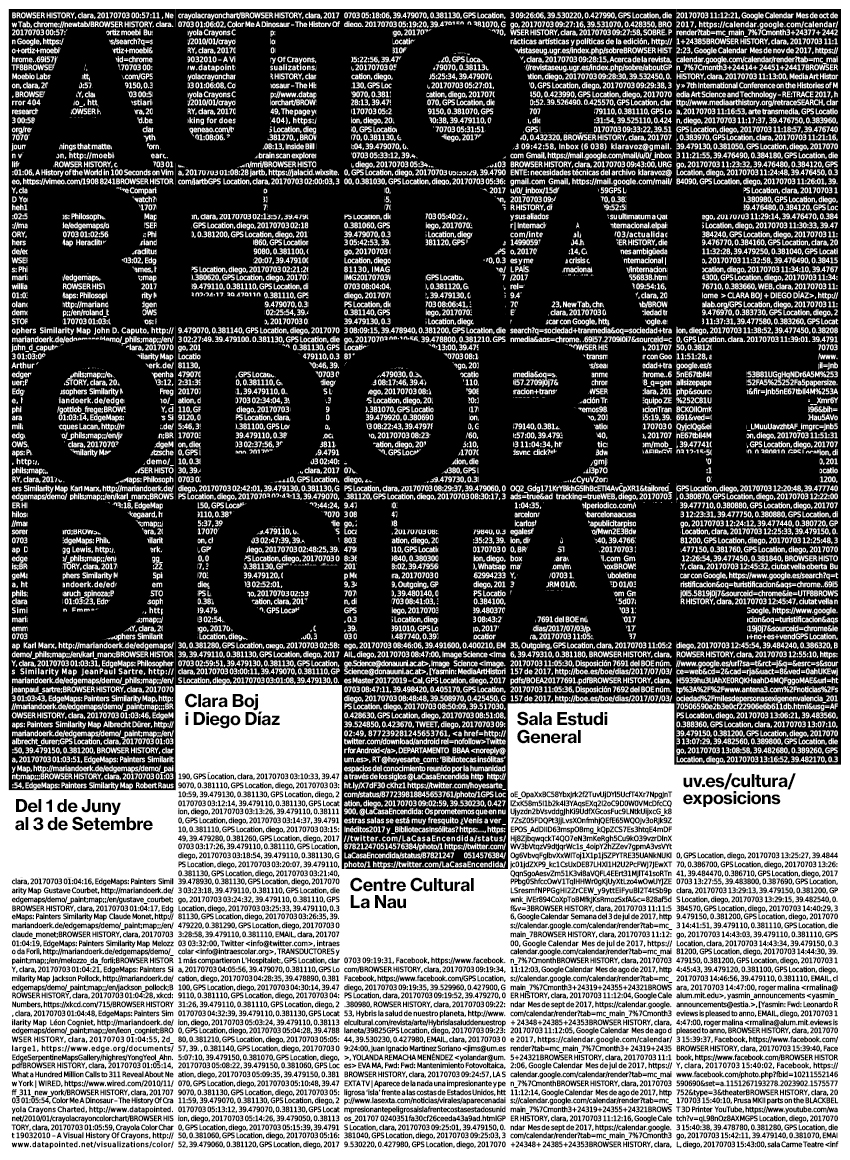Clara Boj and Diego Díaz
Curated by Pau Waelder and Lalalab
Centre Cultural La Nau, Valencia
June 1st – September 3rd, 2023

The contemporary existence inexorably leads into an immense database file updated in real time. Those capture every instant of our life in both, online and offline, through measurements and records captured by the devices surrounding us and by our presence on it. Digitalisation of physical word has transformed data networks in a massive space of information that is almost illegible for citizens. However, it inspires, more and more, market studies, analysis and predictive algorithms that shape our existence.
When we do an internet search, not only do we have access to information, but we also offer information on our interests and enquiries. When we listen to a song through an online music service, we enjoy our favourite authors at the same time that we indicate to the system our preferences and music tastes. Digital life is built in a continuous dialogue between the information that the network offers us and the information on ourselves that we offer to the network and that sets up a kind of shadow of ourselves, a digital double result of a profile creation similar to a robot portrait of our likes, our social and consumption habits and our interactions with other doubles. This profile, that is only our online identity personal expression, with our avatar or with the way in which we voluntarily show ourselves to others in networks, resides in our name and is the subject of marketing and advertising operations, as well as sociological or opinion studies that have (or try to have) an impact in our decisions, our choices and our way of thinking: on balance, in the contemporary life developed in a hybrid continuum between the real and the virtual.
The Autoretrat o doble digital exhibition shows a collection of recent artistic works of Clara Boj and Diego Díaz, which, taking their own identity as a starting point, they ask some questions about present and future life in the datacene, showing the magnitude and complexity of digital archives and exploring the implications that these records have on key aspects such as privacy, intimacy, the definition of personal criteria, security, etc.

In this room full of texts and photos, we explore an aspect of our daily life that is usually ignored: each one of our actions generate data. In a society controlled by information systems and digital devices accompanying us everywhere we go (here, by way of example), all our conversations and movements, everything we consume and share, is filtered by a data server located in a remote location.
This huge quantity of information is not limited to occupy space in those servers. Data is processed, compared, it is arranged forming consumers, tendencies, habits and dependences profiles that are useful for defining our digital double, and, afterwards, shaping it as a perfect consumer. Through artificial intelligence programs, it is possible to process a larger quantity and more complex data, until not only is it possible to detect our actions, but they can also be predicted.
Clara Boj and Diego Díaz started in 2017 a long foray into this hidden dimension of the digital services we use on a daily basis. They created a data biography capturing all the information shared in their mobile phones and including it in 365 books, whose contents are covered in this room. In 2019 they took this project to the next level creating a machine biography that used compiled data for predicting artistic activities in 2050. The current exhibition in La Nau compares both works with a series of derived pieces and add to past and future biographies the present one (data now), showing the daily life of Clara and Diego in TikTok.
Following the self-portrait tradition, artists talk with their digital doubles and invite us to reflect on the data we create every day, since it could also take up a wide range of books and cover the walls of this room.
— Pau Waelder
